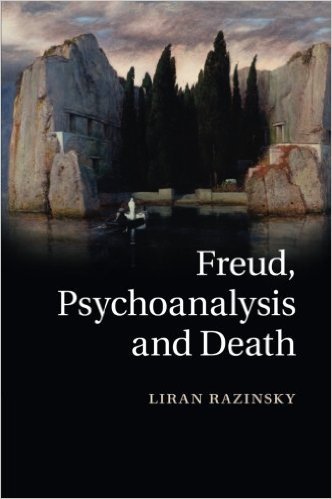Razinsky’s Freud, Psychoanalysis, and Death
By Jerry Piven, PhD | May 16, 2020
Freud, Psychoanalysis, and Death is in many ways a brilliant, provocative, perspicacious venture. Liran Razinsky endeavors to explore: 1) Freud’s complex and contradictory thoughts on death; 2) post-Freudian theory and rejection of death as a significant psychological problem; 3) the pervasiveness of death anxiety and the importance of clinical openness toward a quintessentially human source of concern and dread.
Razinsky begins by delineating the psychoanalytic rationales for rejecting the import of death anxiety. As others have also explicated in considerable detail (Piven, 2004) Freud reduced the fear of death to castration anxiety or guilt, maintained that death could not be represented in the unconscious, and asserted that the psyche could not fathom death since one was always present as a spectator when envisioning one’s own mortality. Space doesn’t permit elaboration of Freud’s complex and contradictory arguments here, as he also argued that the dread of death impels religious beliefs and fantasies of life beyond the grave. Razinsky’s primary innovation in his own book is the detailed analysis of some of the post-Freudians like Klein, Lacan, and Yalom. Razinsky is also at his most provocative (and often beautifully analytical) when dissecting the arguments that reject the importance of the fear of death, and further asseverating that such theoretical refutations are themselves psychologically motivated.
This is also where Razinsky is most precarious, however, since it is immensely difficult to ascertain what the psychological motives for a theory may be. Just because we may believe that death anxiety is profoundly momentous doesn’t ipso facto prove that anyone who rejects such ideas must be in denial (no matter how likely it seems). And where psychoanalysis may indeed suffer all manner of frailties, if nothing else it exposes the utter intricacy of the mind, in its irrationality, conflict, and flights of fantasy. So it seems ironic and perplexing that Razinsky is immersed in a subject so palpably elusive, that itself informs us of the ubiquity of the irrational, while also seeming so certain what the psychological motives for theoretical rejection must be. And further, again despite such awareness of our propensities for irrationality and illusion, throughout the book he uses a language that decisively and apodictically declares others’ ideas to be categorically right, wrong, or failures.
Hence, while some may be concerned with the psychoanalytic rejection of death as a salient source of dread and suffering, Razinsky’s assay also raises some pressing epistemological issues for clinicians as well as anyone at all concerned with human psychology. If indeed Freud and many of his successors continue to reject the psychological importance of death because of our ubiquitous struggles with finitude and nonbeing, as Razinsky contends, then this once again forces us to ask how we can ever know the ways in which our own tribulations color and distort our own perceptions. This epistemological problem should be crucial for any thinker who maintains that perception is vulnerable to corruption by conflict, fear, dread, and desire. If we are beings whose conscious apprehension of the world is distorted by defenses against perceiving or acknowledging that which is too terrifying or painful, and if we deny, dissociate, and distend the world according to our own wishes and fantasies, then we cannot truly know when we are misperceiving things.
Tautologically, a psyche that denies and distorts cannot merely diagnose its own deceptions, since those diagnostic perceptions would be subject to those same distorting dynamics. Denuding perception of distortion, or becoming aware of one’s misperceptions, isn’t just a matter of intelligence or conscious willpower. The belief that one could somehow will oneself to perceive the ways in which one is irrational and deceived by one’s own defenses or fantasies is in itself a fantasy; what Brown (1959) might even call a form of narcissistic inflation in response to the humiliation or dread of being helpless, weak, irrational, confused, and incompetent before one’s illusions and world-mutilating fantasies.
Certitude is no barometer of reality, and neither is the all-too-common cliché that one has been analyzed, and therefore knows oneself. Some may go through sundry meditative, disciplined, psychological ordeals and may come to perceive ways in which their fears and sufferings obscure and mold perception. Nonetheless, the notion that this process has been completed, that one now knows oneself and can always recognize when one is distorting, or even that one is no longer subject to those variegated nonrational perceptual distortions, must inherently be an ego-bolstering fantasy. For even were a person capable of perceiving one’s own tendencies to distort, one would never know for sure, or have a guarantee that these nonrational processes couldn’t permeate perception.
This is especially pertinent for both psychoanalytic and Beckerian thinkers. If one claims that human beings are so utterly terrified and horrified of reality (and death)
that they engage in all manner of reality-mutilating defenses, fantasies, and delusions, then one cannot simply maintain that such processes only apply to everyone else. This should give pause to any thinker of intellectual sophistication (or intellectual humility) before maintaining certainty about any belief or perception. The contrapositive is that conviction, certainty, and dogma about one’s rationality or the truth of one’s beliefs, may be closer to delusional consolations and (again) narcissistic postures than indicators of being correct or rational. For there is no method proved to indefeasibly render a person immune once and for all to the intricate modes of fantasy, distortion, and self-mendacity. If anything, such attitudes may reveal distended egotism, fear, trepidation, overcompensation, and denial, but give us no reason to believe that one has magically transcended those frailties that seem to make so many of us delirious and deceived in our flights from dread.
Does this render all our perceptions equally distorted or deluded? Hardly. It does however lob a torpedo toward that naïve chimeral protest that we know reality (or that we accurately know when we know it). As for hypothetical modes of actually disentangling threads of our figments and fantasies, these may be possible, as suggested above. But possibility can be explored, whereas axiomatically, when a method is employed defiantly or conceitedly as a means of proclaiming one’s own perceptual rationality and that one is immune to those iniquitous, ubiquitous distortions, it is inherently suspect.
____
Jerry S. Piven, Ph.D. has taught at NYU, New School University, and Case Western Reserve University, where his courses have focused on the philosophy of religion, existentialism, psychoanalysis, and metaphysics. He has earned interdisciplinary graduate degrees in the fields of psychology, religion, philosophy, and literature, and has studied at the National Psychological Association for Psychoanalysis training institute. The central focus of Dr. Piven’s research is on the psychology and philosophy of religion, exploring the nature of belief systems, the dynamics of dogma, faith, violence, and apocalyptic eschatologies. He is the editor of The Psychology of Death in Fantasy and History (2004) and Terrorism, Jihad, and Sacred Vengeance (2004), and author of Death and Delusion: A Freudian Analysis of Mortal Terror (2004), The Madness and Perversion of Yukio Mishima (2004), and Nihon No Kyoki (Japanese Madness, 2007). He has recently completed Slaughtering Death: On the Psychoanalysis of Terror, Religion, and Violence.

